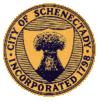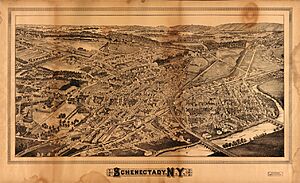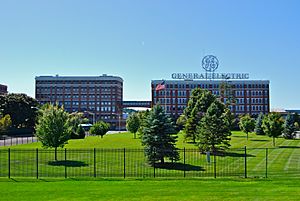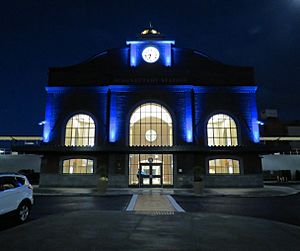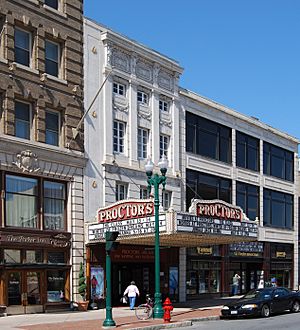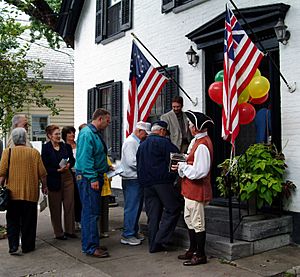Schenectady, New York facts for kids
Quick facts for kids
Schenectady
|
|||
|---|---|---|---|
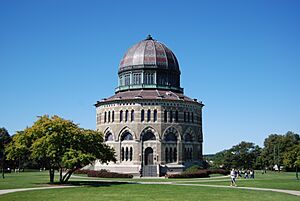
|
|||
|
|||
| Nickname(s):
The Electric City
|
|||
| Motto(s):
"The city that lights and hauls the world."
|
|||
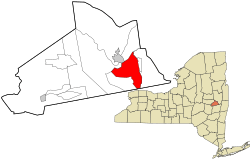 |
|||
| Country | United States | ||
| State | New York | ||
| County | Schenectady | ||
| Region | Capital District | ||
| Settled | 1661 | ||
| Incorporated | 1798 | ||
| Area | |||
| • City | 10.98 sq mi (28.43 km2) | ||
| • Land | 10.81 sq mi (27.99 km2) | ||
| • Water | 0.17 sq mi (0.44 km2) | ||
| Population
(2020)
|
|||
| • City | 67,047 | ||
| • Density | 6,203.46/sq mi (2,395.24/km2) | ||
| • Metro | 1,170,483 | ||
| Time zone | UTC−5 (Eastern (EST)) | ||
| • Summer (DST) | UTC−4 (EDT) | ||
| ZIP code |
12301–12309, 12325, 12345
|
||
| Area code(s) | 518 | ||
| FIPS code | 36-65508 | ||
| GNIS feature ID | 0964570 | ||
Schenectady (pronounced skə-NEK-tə-dee) is a city in Schenectady County, New York. It is the main city of the county. In 2020, about 67,047 people lived there. This made it the ninth-largest city in New York state. The city is in eastern New York, close to where the Mohawk River and Hudson River meet. It is part of the same big city area as Albany, which is the state capital. Albany is about 15 miles (24 km) southeast of Schenectady.
Dutch settlers founded Schenectady in the 1600s. Many came from the Albany area. The name "Schenectady" comes from a Mohawk word, skahnéhtati. It means "beyond the pines" and referred to the area around Albany. The first villagers built farms along the Mohawk River. In the 1800s, Schenectady grew fast because of trade and transportation. This was helped by the Mohawk River and the Erie Canal. By 1824, more people worked in factories than in farming. Important companies like General Electric and American Locomotive Company (ALCO) started here. These companies were very powerful until the mid-1900s. Schenectady has always been involved in new technologies. GE helped build nuclear-powered submarines and now works on renewable energy.
Contents
History of Schenectady
When Europeans first arrived, the Mohawk Valley was home to the Mohawk nation. They were one of the Five Nations of the Iroquois (Haudenosaunee). They had lived in this area since at least 1100 AD. In the early 1600s, the Mohawk moved their villages closer to the river. By 1629, they also took over lands on the Hudson River's west side. These lands were once held by the Mahican people.
In the 1640s, the Mohawk had three main villages. All were on the south side of the Mohawk River. The easternmost village was Ossernenon. When Dutch settlers built Fort Orange (now Albany) in 1614, the Mohawk called their settlement skahnéhtati. This word meant "beyond the pines." It referred to a large area of pine trees between the Mohawk villages and the Hudson River. About 3,200 acres of this special forest are now protected as the Albany Pine Bush. The Dutch settlers started using this word. They used skahnéhtati to describe the new village at the Mohawk flats. This village became known as Schenectady.
In 1661, a Dutch immigrant named Arendt van Corlaer bought a large piece of land. It was on the south side of the Mohawk River. The colonial government gave other settlers land grants in this fertile river valley. The settlers knew the Mohawk people had farmed these lands for hundreds of years. Van Curler took the largest piece of land. The rest was divided into 50-acre plots for the first fourteen owners. Most early settlers came from the Fort Orange area. They may have planned to be fur traders. But the traders in Beverwijck (later Albany) kept control of the fur trade. So, the settlers in Schenectady became farmers. Their 50-acre plots were unique. They were "laid out in strips along the Mohawk River." This was like the French colonial style. They raised livestock and grew wheat. The original owners and their families controlled all the town's land for many years. They acted as the government until after the Revolutionary War.
Dutch colonists often had relationships with Mohawk women. Their children were raised in Mohawk communities. This was because the Mohawk had a family system where the mother's side was most important. These mixed-race children were considered part of their mother's clan. During colonial times, the North American fur trade was a key link between Native Americans and colonists. Dutch colonists also brought enslaved Africans to work on farms in Schenectady.
Some people of mixed European and Native American heritage became important. For example, Jacques Cornelissen Van Slyck and his sister Hilletie van Olinda. They had Dutch, French, and Mohawk ancestors. They became interpreters and married Dutch colonists. They also gained land in Schenectady. In 1664, an English fleet took over the Dutch colony of New Netherland. They renamed it New York. The English kept Albany's control over the fur trade. They stopped Schenectady from trading furs until 1670 and later. Settlers bought more land from the Mohawk in 1670 and 1672.
On February 8, 1690, during King William's War, French forces and their Native American allies attacked Schenectady. They surprised the town, killing 62 people, including 11 enslaved Africans. This event is known as the Schenectady massacre. Twenty-seven people were taken captive. The raiders took them about 200 miles (320 km) to Montreal. Young captives were often adopted by Mohawk families. In 1748, during King George's War, the French and Native Americans attacked Schenectady again. This time, 70 residents were killed.
In 1765, Schenectady became a borough. During the American Revolutionary War, the local militia fought in the Battle of Saratoga. They also fought against Loyalist troops. Some settlers from Schenectady were Loyalists. They moved to Canada in the later parts of the Revolution.
Schenectady in the New Republic
After the Revolutionary War, the town gained a representative government. Schenectady became a city in 1798. In 1795, the city's three oldest churches started Union College. This school had begun in 1785 as Schenectady Academy. This was part of a growth in higher education in upstate New York.
Many people moved to upstate and western New York after the war. They came from New England, England, and Europe. Many traveled west along the Mohawk River. They settled in the western part of the state. In 1819, a fire destroyed over 170 buildings in Schenectady. Most of its old Dutch-style buildings were lost.
New York passed a law to slowly end slavery in 1799. However, in 1824, there were still 102 enslaved people in Schenectady County. Nearly half lived in the city. The last enslaved people in Schenectady became free in 1827.
In the 1800s, Schenectady became an important center for transportation, manufacturing, and trade. This happened after the Erie Canal was finished in 1825. By 1824, more people worked in factories than in farming or trade. The city also had a cotton mill. This mill processed cotton from the southern states.
Schenectady grew because of more traffic connecting the Hudson River to the Mohawk Valley and the Great Lakes. The Albany and Schenectady Turnpike (now State Street) was built in 1797. It connected Albany to towns in the Mohawk Valley. The Albany and Schenectady Railroad started in 1831. It was one of the first railways in the United States. It connected Schenectady and Albany. Developers in Schenectady quickly built more railroads. This made Schenectady "the rail hub of America at the time."
In the 1830s, the abolitionist movement grew in Schenectady. In 1836, Reverend Isaac Groot Duryee helped start the Anti-Slavery Society at Union College. He also started the Anti-Slavery Society of Schenectady in 1837. People seeking freedom were helped by the Underground Railroad. This route passed through the area, going west and north to Canada.
In 1887, Thomas Edison moved his Edison Machine Works to Schenectady. In 1892, Schenectady became the main office of the General Electric Company. This company became a huge industrial and economic power. It helped make the city a national manufacturing center. American Locomotive Company (ALCO) also grew here. It was the second-largest maker of steam locomotives in the US. Later, it developed diesel technology.
Schenectady in the 20th Century and Today
In the early 1900s, Schenectady attracted many new immigrants. They came from eastern and southern Europe to work in the new factories. Many African Americans also moved here from the rural South. General Electric and ALCO were very powerful companies. They led to new ideas in many areas across the country.
Schenectady is home to WGY, the second commercial radio station in the United States. In 1928, General Electric made the first regular television broadcasts in the US. This TV station is now WRGB.
The city's population was largest in 1930, with about 95,000 people. The Great Depression caused many job losses and a drop in population. After World War II, some people moved to new homes in the suburbs. General Electric also built some high-tech facilities in nearby Niskayuna. This helped the county's population grow. In the late 1900s, Schenectady lost many jobs. This was due to big changes in industries. Since the late 1900s, the city has been building a new economy. It focuses partly on renewable energy. Its population grew from 2000 to 2010.
Geography of Schenectady
Schenectady covers about 11.0 square miles (28.4 km²). Most of it is land. It is part of the Capital District. This is the area around Albany, the state capital. Schenectady, Albany, and Troy are the three main cities in this region.
Interstate 890 goes through Schenectady. The New York State Thruway (Interstate 90) is also nearby. Amtrak has a train station in Schenectady. The closest airport is Schenectady County Airport. The closest commercial airport is Albany International Airport.
Schenectady has a humid continental climate. This means it has hot summers. Average monthly temperatures range from 22.9°F (-5.1°C) in January to 71.8°F (22.1°C) in July.
 |
Mohawk River Town of Glenville Village of Scotia |
Mohawk River |
 |
|
| Town of Rotterdam | Town of Niskayuna Hamlet of Niskayuna |
|||
| Town of Rotterdam Hamlets of Rotterdam and Carmen |
Albany County Town of Colonie |
Town of Niskayuna Hamlet of Stanford Heights |
Economy of Schenectady
Schenectady was known as "The City that Lights and Hauls the World." This referred to two big companies: Edison Electric Company (now General Electric) and American Locomotive Company (ALCO).
GE still has its steam turbine factories in Schenectady. Its Global Research center is in nearby Niskayuna. However, many manufacturing jobs have moved from Schenectady to other places.
ALCO made steam locomotives for railroads for many years. During World War II, it made tanks for the US Army. Later, ALCO worked with GE to make diesel locomotives. But ALCO's operations slowly ended. Its Schenectady factory closed in 1969.
In the late 1900s, Schenectady lost many jobs. This was like many other old factory cities in New York. The city's population dropped by almost one-third from 1950 to the late 1900s. The old factories also left many areas with harmful waste.
In the 2000s, Schenectady started to rebuild. GE opened a renewable energy center. This brought hundreds of jobs to the area. The city is part of a growing economy. Many buildings have been fixed up for new uses. Many small businesses, shops, and restaurants have opened downtown.
Price Chopper Supermarkets and the New York Lottery have their main offices in Schenectady.
In 2014, the state chose Schenectady for a new casino project. This project would rebuild an old ALCO factory site. It would include hotels, homes, and a marina, along with the casino. In February 2017, the Rivers Casino & Resort opened. It has many games, a steakhouse, and a restaurant. The project cost $480 million. It also includes two hotels, condos, apartments, and office space for tech companies.
People of Schenectady
| Historical population | |||
|---|---|---|---|
| Census | Pop. | %± | |
| 1800 | 5,289 | — | |
| 1810 | 5,903 | 11.6% | |
| 1820 | 3,939 | −33.3% | |
| 1830 | 4,268 | 8.4% | |
| 1840 | 6,784 | 59.0% | |
| 1850 | 8,921 | 31.5% | |
| 1860 | 9,579 | 7.4% | |
| 1870 | 11,026 | 15.1% | |
| 1880 | 13,655 | 23.8% | |
| 1890 | 19,902 | 45.7% | |
| 1900 | 31,682 | 59.2% | |
| 1910 | 72,826 | 129.9% | |
| 1920 | 88,723 | 21.8% | |
| 1930 | 95,692 | 7.9% | |
| 1940 | 87,549 | −8.5% | |
| 1950 | 91,785 | 4.8% | |
| 1960 | 81,070 | −11.7% | |
| 1970 | 77,958 | −3.8% | |
| 1980 | 67,972 | −12.8% | |
| 1990 | 65,566 | −3.5% | |
| 2000 | 61,821 | −5.7% | |
| 2010 | 66,135 | 7.0% | |
| 2020 | 67,047 | 1.4% | |
| U.S. Decennial Census | |||
In 2010, there were 66,135 people living in Schenectady. The city's population is very diverse. The main groups are White, African American, and Hispanic or Latino. There is also a growing population from Guyana. The top family backgrounds reported by people were Italian, Guyanese, Irish, Puerto Rican, German, English, and Polish.
The Schenectady City School District is also very diverse. In 2013, about 80% of students received free or reduced-price lunch. The student population is made up of many different groups. In 2016, the high school graduation rate was 56%.
In 2010, about 31.2% of households had children under 18. About 28.0% were married couples. The average household had 2.23 people. The median income for a household in 2010 was $37,436. About 25.9% of the population lived below the poverty line.
Religion in Schenectady
The largest religious group in Schenectady is the Catholic church, with 44,000 members. Islam is the second largest, with 6,000 followers. The third largest is the Reformed Church in America, with 3,600 members. The United Methodist church is fourth, with 2,800 members.
Some notable churches include the First Presbyterian Church (Schenectady, New York) and the First Reformed Church RCA. St George's Episcopal Church dates back to 1735.
Transportation in Schenectady
Amtrak, the national passenger train system, serves Schenectady. The Schenectady station is at 322 Erie Boulevard. Trains like the Ethan Allen and Lake Shore Limited stop here. Schenectady also has freight train service.
The Capital District Transportation Authority (CDTA) provides bus service. You can take buses throughout Schenectady. You can also connect to nearby cities like Albany, Saratoga Springs, and Troy.
In the early 1900s, Schenectady had a large streetcar system. It offered local and intercity passenger service. The Schenectady Railway Co. had lines to Albany, Ballston Spa, Saratoga Springs, and Troy. There was also a line from Gloversville, Johnstown, Amsterdam, and Scotia into Downtown Schenectady. This line was run by the Fonda, Johnstown, and Gloversville Railroad.
The Mohawk River in Schenectady is crossed by the Western Gateway Bridge. It was first built in 1923-25 and replaced in 1971.
Places to Visit in Schenectady
- Proctors Theatre is an arts center. It was built in 1926 as a vaudeville and movie theater. It has been updated in the 2000s. It has "Goldie," a Wurlitzer theater pipe organ. Proctors was also where one of the first public television shows was seen.
- The Stockade Historic District has many Dutch and English Colonial houses. These homes are from the 1700s and 1800s. It was New York state's first historic district, named in 1965. It is named after the old wooden fence that once surrounded the colonial town.
- The Schenectady County Historical Society has a History Museum. It also has the Grems-Doolittle research library. Both are at 32 Washington Avenue in the Stockade District. The museum tells the story of Schenectady. It has exhibits on the Yates Doll House and the Erie Canal.
- The General Electric Realty Plot is near Union College. It was one of the first planned neighborhoods in the U.S. It was designed to attract GE executives. It has many grand homes in different styles. It is home to the first all-electric home in the United States.
- Union College, next to the GE Realty Plot, is the oldest planned college campus in the United States. The campus has the unique 16-sided Nott Memorial building, built in 1875. It also has Jackson's Garden, 8 acres (32,000 m²) of gardens and woodlands.
- Central Park is a beautiful park in Schenectady. It is at the highest point in the city. The park has a famous rose garden and Iroquois Lake.
- The Schenectady Museum has exhibits about science and technology. It also has the Suits-Bueche Planetarium.
- Schenectady City Hall is the main building for city government. It was designed by McKim, Mead and White. It was built in 1933 during the Great Depression.
- Schenectady's Municipal Golf Course is an 18-hole course. It was designed in 1935.
- Jay Street is a short street between Proctors and City Hall. Part of it is closed to cars. It has many small, local businesses and restaurants. It is a popular place to visit. Just past the walking part of Jay Street is Schenectady's Little Italy.
- Schenectady Light Opera Company (SLOC) is a community theater group. It is on Franklin Street in downtown Schenectady.
- The Edison Tech Center shows how engineering and technology developed. It has online and on-site displays. These help people learn about electricity and its uses.
- Upper Union Street Business Improvement District is near Niskayuna. It has almost 100 local businesses. These include restaurants, shops, and salons.
- Vale Cemetery, listed on the National Register of Historic Places, has over 30,000 burials. It includes the historic African-American Burying Ground. City residents celebrate Juneteenth and Emancipation here each year.
Education in Schenectady
The city is served by the Schenectady City School District. It has 16 elementary schools, three middle schools, and Schenectady High School. Brown School is a private school for kindergarten through 8th grade. Catholic schools are run by the Diocese of Albany.
Wildwood School is a special education school for all ages.
Schenectady also has two colleges. Union College is a private liberal arts college. Schenectady County Community College is a public community college.
Notable People from Schenectady
- Stephen Alexander (1806–1883), astronomer and educator
- Horatio Allen (1802–1889), railroad engineer
- Ralph Alpher (1921–2007), scientist known for work on the Big Bang theory
- Chester Arthur (1829–1886), U.S. president, went to Union College
- Kumar Barve (born 1958), first Indian-American legislator in Maryland
- Katharine Burr Blodgett (1898 – 1979), physicist and chemist
- Andy Bloom (born 1973), Olympic shotputter
- Jim Barbieri (born 1941), MLB player
- Maria Brink (born 1977), lead singer of In This Moment
- Pat Cadigan (born 1953), science fiction author
- Greg Capullo (born 1962), comic book artist
- Bruce W. Carter (1950–1969), USMC, Medal of Honor winner
- Jimmy Carter (1924–2024), U.S. president, studied at Union College
- Billy Connors (1941–2018), MLB pitcher and coach
- Mary Daly (1928–2010), feminist writer
- Ann B. Davis (1926–2014), actress (Alice on The Brady Bunch)
- Antonio Delgado (born 1977), Lieutenant Governor of New York
- John Owen Dominis (1832–1891), prince consort of Hawaii
- Jamie Dukes (born 1964), football player
- Harry J. Flynn (1933–2019), Roman Catholic archbishop
- Henry Glen (1739–1814), U.S. representative
- Harold Gould (1923–2010), actor (The Golden Girls)
- Harold J. Greene (1959–2014), United States Army general
- Kevin Greene (1962–2020), football player and coach
- John E. Hart (1824–1863), Union Navy officer
- Patricia Kalember (born 1957), actress
- Steve Katz (born 1945), guitarist (Blood, Sweat & Tears)
- Barry Kramer (born 1942), basketball player and judge
- Irving Langmuir (1881–1957), Nobel Prize winner in chemistry
- Wayne LaPierre (born 1949), CEO of the National Rifle Association of America
- Arnold Lobel (1933–1987), children's book author
- George R. Lunn, (1873–1948), mayor and U.S. representative
- Ranald MacDougall (1915–1973), screenwriter and director
- Sir Charles Mackerras (1925–2010), Australian conductor
- Donald Martiny (born 1953), artist
- Tom Moulton (born 1940), record producer
- Shirley Muldowney (born 1940), auto racer
- Mordecai Myers (1776–1871), mayor of Schenectady
- Ray Nelson (born 1931), science-fiction author
- Eliphalet Nott (1773–1866), president of Union College
- David Opdyke (born 1969), visual artist
- John Palasik (1954–2022), Vermont state legislator
- Joseph S. Pulver (1955–2020), novelist and poet
- Pat Riley (born 1945), NBA coach
- Ron Rivest (born 1947), cryptographer, co-inventor of RSA
- Lewis K. Rockefeller (1875–1948), U.S. representative
- Mickey Rourke (born 1952), actor
- R. Tom Sawyer (1901–1986), engineer and inventor
- John Sayles (born 1950), film director and screenwriter
- Vincent J. Schaefer (1906–1993), chemist and meteorologist
- Michael H. Schill (born 1958), president of Northwestern University
- Ben Schwartz (born 1981), actor (Jean-Ralphio on Parks and Recreation)
- William H. Seward (1801–1872), U.S. Secretary of State
- Kenneth Schermerhorn (1929–2005), conductor
- Charles Proteus Steinmetz (1865–1923), electrical engineer
- Brian U. Stratton (born 1957), mayor
- Samuel S. Stratton (1916–1990), mayor and U.S. representative
- John Sykes (born 1955), co-founder of MTV
- Frank Taberski (1889–1941), billiards champion
- Lynne Talley (born 1954), oceanographer
- John Tudor (born 1954), MLB pitcher
- Deborah Van Valkenburgh (born 1952), actress
- Kurt Vonnegut (1922–2007), author, lived in Schenectady
- Lee Wallard (1910–1963), race car driver
- Casper Wells (born 1984), MLB outfielder
- George Westinghouse (1846–1914), engineer and inventor
- Andrew Yang (born 1975), entrepreneur and political candidate
- Joseph Christopher Yates (1768–1837), governor of New York
See also
 In Spanish: Schenectady para niños
In Spanish: Schenectady para niños



